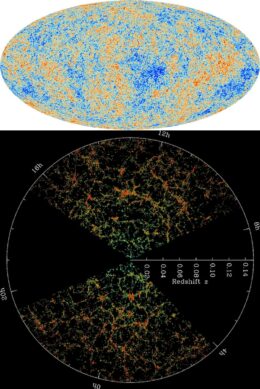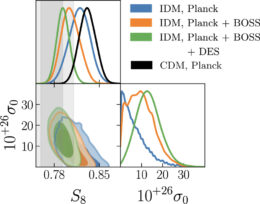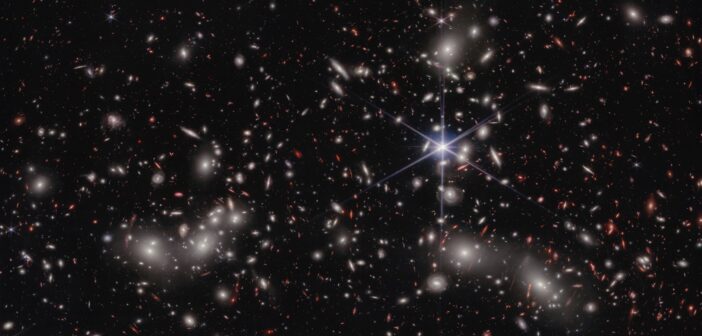Dark matter, which makes up 85% of the matter in the universe, is thought to interact with normal matter only through gravity. If dark matter and normal matter could interact through collisions, what would that mean for our models of the universe?

Measurements of S8 made from the fluctuations in the cosmic microwave background radiation (top) and the distribution of nearby galaxies (bottom) do not agree. [Top: ESA and the Planck Collaboration; Bottom: M. Blanton and the Sloan Digital Sky Survey]
Clumpiness in Conflict
Our best cosmological model, called lambda-CDM, describes a universe dominated by dark energy, dark matter, and normal matter, in that order. Lambda-CDM has weathered many challenges, but a couple of nagging disagreements have prompted some researchers to propose tweaks or outright rewrites of this leading theory of cosmology.
The first and most famous issue is the Hubble tension: the disagreement between different methods of measuring the expansion rate of the universe. The second issue, and the subject of today’s article, has to do with how clumpy or uniform matter is in our universe. The “clumpiness” parameter, called S8, measured in the nearby universe from observations of galaxy clusters is smaller than what we measure in the distant universe from the cosmic microwave background radiation — the oldest light in the universe, hearkening back to just 380,000 years after the Big Bang. In an attempt to relieve this tension, researchers have explored the effects of loosening one of our fundamental assumptions about dark matter.
Dark Matter Can Have a Little Interaction, as a Treat
In the lambda-CDM model, dark matter is only capable of interacting with normal matter through gravity. This means that dark matter can’t bump into normal matter; a dark-matter particle cruising through your body would have no effect at all. In a recent research article, a team led by Adam He (University of Southern California) suggested that tweaking this property of dark matter could solve our problems with the S8 tension.

Posterior distributions resulting from different data combinations under the interacting dark matter (IDM) model. [He et al. 2023]
A Preference for Interacting Dark Matter?
When the team looped in data from the Planck spacecraft, which measured the cosmic microwave background radiation, and the Dark Energy Survey, which has mapped the locations of hundreds of millions of galaxies, they found that the data actually slightly lean toward a scenario in which dark matter and normal matter lightly interact.

Commissioning images from the Euclid space telescope. [ESA/Euclid/Euclid Consortium/NASA; CC BY-SA 3.0 IGO]
Citation
“S8 Tension in the Context of Dark Matter–Baryon Scattering,” Adam He et al 2023 ApJL 954 L8. doi:10.3847/2041-8213/acdb63

